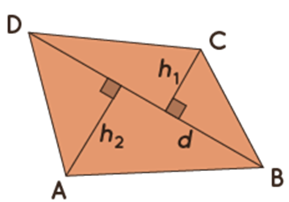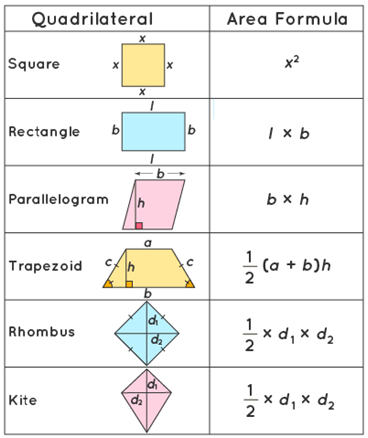About Quadrilateral Area Formulas
The area of a closed figure with four sides, known as a quadrilateral, is calculated using quadrilateral area formulas. Different varieties of quadrilaterals exist based on the qualities of various parameters. The quadratic area formulas will be covered in the following sections.
What are Quadrilateral Area Formulas?
Quadrilateral area formulas are used to compute the area of a closed figure having four sides, known as a quadrilateral. Quadrilaterals come in variety of shapes & sizes, depending on the properties of several parameters. The following sections will go over the quadratic area formulas.
When a quadrilateral is divided into separate triangles, as seen in the illustration below:

we have 2 triangles BCD and ABD
Calculating the areas of the triangles separately,
Area of triangle BCD = (1/2) × d ×h1h1
Area of triangle ABD = (1/2) × d ×h2h2
Area of quadrilateral ABCD = Sum of areas of ΔBCD and ΔABD.
Thus, area of the quadrilateral ABCD = (1/2) × d ×h1+ (1/2) × d ×h2= (1/2) × d × (h2+h2).
When one of the quadrilateral formula's diagonals and the heights of the triangles (formed by the provided diagonal) are known, the area of the quadrilateral formula is,
Area = (1/2) × Diagonal × (Sum of heights)

List of Quadrilateral Area Formulas
|
Name of Quadrilateral |
Area of Quadrilateral Formulas |
|---|---|
| Square | (side)2 |
| Rhombus | (1 ⁄ 2) × product of diagonals |
| Kite | (1 ⁄ 2) × product of diagonals |
| Parallelogram | base × height |
| Rectangle | length × breadth |
| Trapezoid | 1/2 × (sum of the lengths of parallel sides) × height |
Our experts prepared a List of all Maths formulas used in different calculations.